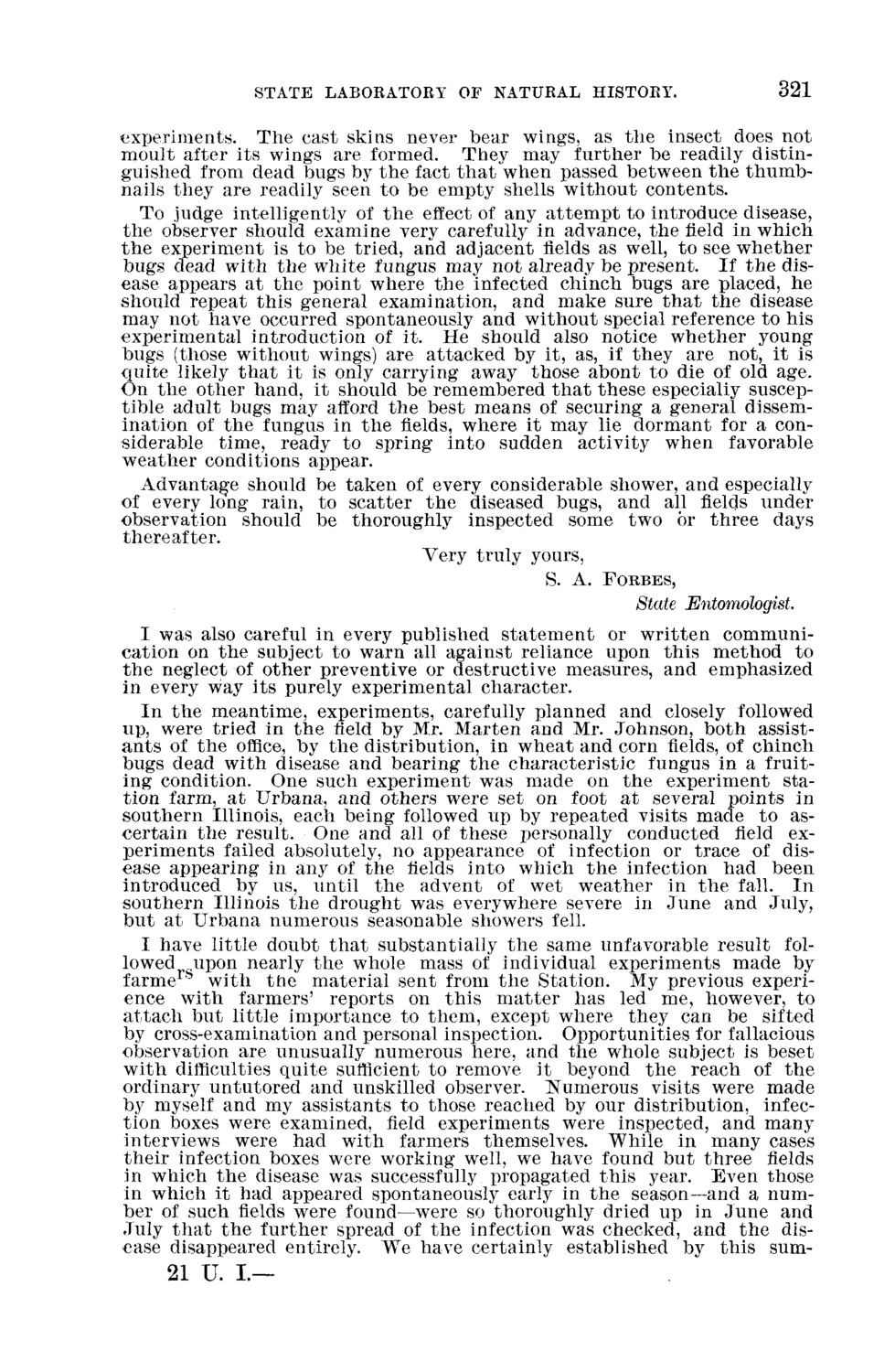| |
| |
Caption: Board of Trustees Minutes - 1894
This is a reduced-resolution page image for fast online browsing.

EXTRACTED TEXT FROM PAGE:
STATE LABORATORY OF NATURAL HISTORY. 321 experiments. The cast skins never bear wings, as the insect does not moult after its wings are formed. They may further be readily distinguished from dead bugs by the fact t h a t when passed between the thumbnails they are readily seen to be empty shells without contents. To judge intelligently of the effect of any attempt to introduce disease, the observer should examine very carefully in advance, the field in which t h e experiment is to be tried, and adjacent fields as well, to see whether bugs dead with the white fungus may not already be present. If t h e disease appears at the point where the infected chinch bugs are placed, he should repeat this general examination, and make sure t h a t the disease may not have occurred spontaneously and without special reference to his experimental introduction of it. He should also notice whether young bugs (those without wings) are attacked by it, as, if they are not, it is quite likely t h a t it is only carrying away those abont to die of old age. On the other hand, it should be remembered t h a t these especially susceptible adult bugs may afford the best means of securing a general dissemination of the fungus in the fields, where it may lie dormant for a considerable time, ready to spring into sudden activity when favorable weather conditions appear. Advantage should be taken of every considerable shower, and especially of every long rain, to scatter the diseased bugs, and all fields under observation should be thoroughly inspected some two or three days thereafter. Yery truly yours, S. A. FORBES, State Entomologist. I was also careful in every published statement or written communication on the subject to warn all against reliance upon this method to the neglect of other preventive or destructive measures, and emphasized in every way its purely experimental character. In the meantime, experiments, carefully planned and closely followed up, were tried in the field by Mr. Marten and Mr. Johnson, both assistants of the office, by the distribution, in wheat and corn fields, of chinch bugs dead with disease and bearing the characteristic fungus in a fruiting condition. One such experiment was made on the experiment station farm, at Urbana, and others were set on foot at several points in southern Illinois, each being followed up by repeated visits made to ascertain the result. One and all of these personally conducted field experiments failed absolutely, no appearance of infection or trace of disease appearing in any of the fields into which the infection had been introduced by us, until the advent of wet weather in t h e fall. In southern Illinois the drought was everywhere severe in June and July, but at Urbana numerous seasonable showers fell. I have little doubt t h a t substantially the same unfavorable result followed ripon nearly the whole mass of individual experiments made by farme with the material sent from the Station. My previous experience with farmers' reports on this matter has led me, however, to attach but little importance to them, except where they can be sifted by cross-examination and personal inspection. Opportunities for fallacious observation are unusually numerous here, and the whole subject is beset with difficulties quite sufficient to remove it beyond t h e reach of the ordinary untutored and unskilled observer. Numerous visits were made by myself and my assistants to those reached by our distribution, infection boxes were examined, field experiments were inspected, and many interviews were had with farmers themselves. While in many cases their infection boxes were working well, we have found but three fields in which the disease was successfully propagated this year. Even those in which it had appeared spontaneously early in the season—and a number of such fields were found—were so thoroughly dried up in June and July t h a t the further spread of the infection was checked, and the disease disappeared entirely. We have certainly established by this sum- 21 U. L—
| |